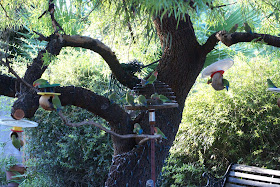
One day about seven years ago we heard an unusual sound coming from the backyard. While we thought it was probably a bird it didn't sound at all familiar. A few days later we saw a flash of green in our big African Sumac tree—it was a small green bird with a peach colored face. It turned out to be a Peach Faced Parrot, also called a Peach Faced Lovebird and other similar names. They were casual occasional visitors to our place for about a year. We then added a pair of fountains to the patio—one close to the tree and a wall fountain on the west wall. The fountains did the trick and soon we had parrots most of the time, with many more showing up in the summer months, especially drawn to the fountains.
Peach Faced parrots are native to an area of southwest Africa that is hot and arid. There they tend to congregate near water. They were brought to this country as pets, and inevitably some escaped. The ones that escaped in the Phoenix area said “Hot damn! We've died and gone to heaven! It's hot, looks like there's food and look at all that water! Swimming pools, canals, sprinklers, bird baths and FOUNTAINS! Wow!”

The first sighting of escapees in the Phoenix area that I have found reference to were by an ASU biology professor along the Mesa-Apache Junction border in 1986 or 1987. In the ensuing 25 or so years they have spread all over the valley. There is no doubt that they are breeding rather successfully. They are cavity nesters and some people were afraid they were going to displace native species, but that doesn't seem to be the case. The Arizona Fish and Insane Department gave them their official blessing last year, saying they would let them stay. Like there was anything they could do about it. They like to roost and make nests in the type of palm tree shown here. Other birds, such as pigeons and barn owls, also like these trees, which creates some interesting situations.

Overheard in Apartment 14B: “Marge, want to eat out tonight?” “No, I'm tired. The parrots got up early this morning and have been squawking all day. Let's stay home and have squab. There's some downstairs in 12A that are about ready.”

The layout of our back yard re birds is shown in the photo above. The African Sumac provides shade as well as some protection from predators. In the winter we have a Cooper's hawk in the neighborhood who makes life a challenge for the smaller birds, so the cover is necessary. The fountain that the birds like best is on the right. There are four feeders made from coconuts hanging in the Sumac and one pan feeder with a wire basket over it to keep out the doves.
The photo below shows an adult parrot with an adult house finch for scale. Incidentally, the finches love the oranges but the parrots completely ignore the oranges and any other fruit we have tried. They seem to be strictly seed eaters.

Below are photos of an adult parrot eating seed from one of the coconuts in approved parrot fashion. The hats on the coconut are there to prevent doves, particularly white wings, from hanging on and getting or trying to get seed.


The parrots also like to eat from the pan, as you can see here.

The photo below shows all the feeders in action, with the far right feeder barely visible. This photo was taken in September. I believe the most parrots we have had at one time is about 30.

The fountain is the big attraction. In the hottest part of the summer the word seems to be out that the parrot bar is open, and happy hour starts about 5:00 pm. They come in straight to the fountain without bothering with food. They will sit their and chatter and drink and may sit there for a number of minutes without going anywhere. Below are photos of this action.




I apologize that this last photo is not as sharp as it should be. I think we counted about 30 parrots on the fountain at one time.
The photo below shows a juvenile. Juveniles have black on the portion of their bill closest to their head. Juveniles are hilarious to watch when they first come to our yard. They have trouble figuring out how to get in and out of the feeder with the basket on it, are a little intimidated by the fountain, and have trouble learning how to hang on to the coconuts and eat at the same time. Great fun.

If someone says to you that there are no parrots in Arizona, you can smile knowingly and say "Oh yes there are."








